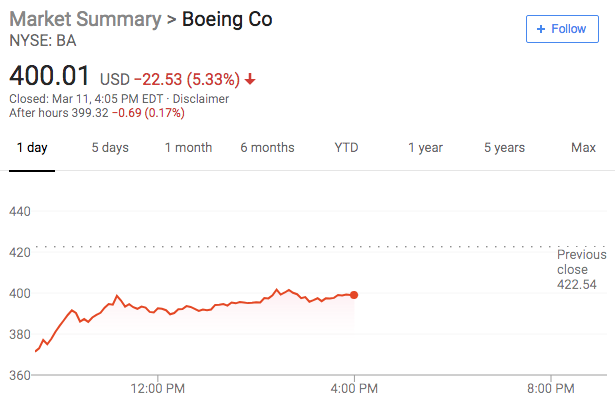U.S. stocks rose and the Dow (^DJI) shook off earlier declines after a drop in shares of aerospace giant Boeing (BA) weighed on the index. Stronger-than-expected retail sales figures for January helped buoy confidence among market participants.
The industrials-heavy Dow rose 0.81%, or 207.34 points, as of 3:39 p.m. ET. A deadly crash of a Boeing 737 Max 8 aircraft on Sunday led shares of the aerospace giant to drop more than 11% as of market open. These declines generated an about 300-point drag on the Dow in early trading, with Boeing comprising about 10.9% of the industrials-heavy index.
Shares of Boeing fell as much as 13.5% to $365.55 shortly after market open.
Gains in shares of other Dow components including Apple (AAPL) helped offset Boeing’s declines. Bank of American Merrill Lynch upgraded shares of Apple to Buy from Neutral on Monday and raised its price target to $210 from $180, sending shares of the tech giant higher by about 3.5% as of 3:45 p.m. ET. BofAML said the stock’s recent pullback created a buying opportunity and cited potential in the company’s health-care, wearables and services segments.
The other major domestic indices have continued to climb during Monday’s session. The S&P 500 (^GSPC) rose 1.47%, or 40.37 points, with the Tech sector leading advances. The Nasdaq (^IXIC) rose 2.02%, or 149.55 points.
Each of the three major indices posted weekly losses of more 2% on Friday as a beginning-of-the-year U.S. equity rally began to cool. The S&P 500 was up 9.4% for the year-to-date through Friday, after having been up 11.5% through the end of February, marking the best start to the year since 1991.
“After hovering around Q4 resistance levels, the SPX has posted its biggest pullback of the year. Some factors likely at play are the swelling trade deficit, slowing global growth, and mixed jobs data,” said Chris Larkin, senior vice president of trading at E-Trade Financial Corporation. “As more and more fundamental signs start to creep up that we could be approaching the end of this bull market, traders have rotated into a defensive stance with real estate and utilities.”
However, “while last week may have felt pretty brutal, it’s important to remember that we’re still in a high range and it’s been a very strong year so far for the market,” Larkin added.
Retail sales
Market participants on Monday got a dose of good news with better-than-expected January retail sales results, which marked a turnaround from December’s sharply underwhelming reading. The headline reading on retail sales rose 0.2% in January, following a downwardly revised 1.6% decline in December, the Census Bureau reported Monday. The revised December results were even weaker than the 1.2% drop previously reported, which itself had been the worst reading in 9 years.
A control group for retail sales – viewed by many economists as a better gauge of consumer demand – rose 1.1% in January, above the 0.6% gain expected and the downwardly revised 2.3% drop in December. This group excludes sales from the food services, automobile dealers, building materials and gasoline stations segments.
“The January details show that the rebound was uneven, with big gains in building materials (3.3% m/m), sporting goods (4.8%), and non-store retailers (2.6%) but weakness in furniture (-1.2%), and electronics (-0.3%), while department store sales were little changed after a huge 3.0% drop,” Ian Shepherdson of Pantheon Macroeconomics wrote in a note Monday. “Overall, these data signal a clear increase in total consumers’ spending in January, but the adverse base effect from December’s drop – which will be revised down – means that Q1 real consumption will struggle mightily to reach 2% growth, and a mere 1% is entirely possible.”

























